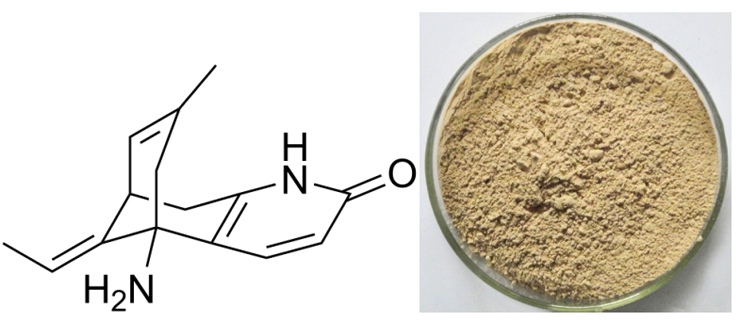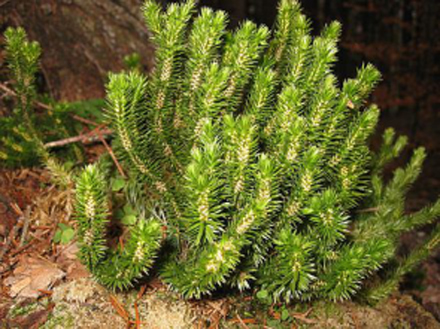Low MOQ for Huperzine A Factory for Venezuela
Low MOQ for Huperzine A Factory for Venezuela Detail:
[Latin Name]Huperzia serratum
[Source] Huperziceae whole herb from China
[Appearance]Brown to white
[Ingredient]Huperzine A
[Specification]Huperzine A 1% – 5%, HPLC
[Solubility] Soluble in chloroform, methanol, ethanol, slightly soluble in water
[Particle size] 80 Mesh
[Loss on drying] ≤5.0%
[Heavy Metal] ≤10PPM
[Pesticide residue] EC396-2005, USP 34, EP 8.0, FDA
[Storage] Store in cool & dry area, keep away from the direct light and heat.
[Shelf life] 24 Months
[Package] Packed in paper-drums and two plastic-bags inside.
[What is Huperzine A]
Huperzia is a type of moss that grows in China. It is related to club mosses (the Lycopodiaceae family) and is known to some botanists as Lycopodium serratum . The whole prepared moss was used traditionally. Modern herbal preparations use only the isolated alkaloid known as huperzine A. Huperzine A is an alkaloid found in huperzia that has been reported to prevent the breakdown of acetylcholine, an important substance needed by the nervous system to transmit information from cell to cell. Animal research has suggested that huperzine A’s ability to preserve acetylcholine may be greater than that of some prescription drugs. Loss of acetylcholine function is a primary feature of several disorders of brain function, including Alzheimer’s disease . Huperzine A may also have a protective effect on brain tissue, further increasing its theoretical potential for helping reduce symptoms of some brain disorders.
[Function] Used in alternative medicine, huperzine A has been found to act as a cholinesterase inhibitor, a type of medicine used to prevent the breakdown of acetylcholine (a chemical essential to learning and memory).
Not only used as a treatment for Alzheimer’s disease, huperzine A is also said to enhance learning and memory and to protect against age-related cognitive decline.
In addition, huperzine A is sometimes used to boost energy, increase alertness, and aid in the treatment of myasthenia gravis (an autoimmune disorder that affects the muscles).
Product detail pictures:

Related Product Guide:
carry on to boost, to guarantee products excellent in line with market and consumer standard specifications. Our enterprise has a quality assurance system are actually established for Low MOQ for Huperzine A Factory for Venezuela , The product will supply to all over the world, such as: Melbourne, Jamaica, Hungary, At Present, our merchandise have been exported to more than sixty countries and different regions, such as Southeast Asia, America, Africa, Eastern Europe, Russia, Canada etc. We sincerely hope to establish wide contact with all potential customers both in China and the rest part of the world.
This video introduces us to the cell wall.
This is a product of Mexus Education Pvt. Ltd., an education innovations company based in Mumbai, India.
https://www.mexuseducation.com, https://www.ikenstore.in
Natural Male Enhancement @ https://simplemaleenhancement.com
Millions of men throughout the world are searching everyday for natural male enhancement techniques because they do not want to go down the route of surgery or resort to expensive and possibly dangerous pills, powders or potions. These methods are not fool proof and can be quite costly, plus have numerous negative side-effects.
Luckily, the company Ideal Fitness Trends has just released these 3 free videos for men all over the world who are looking for techniques on how to increase penis size naturally.
According to the videos and their descriptions, one of the best ways to increase the size of one’s genital organ is through the use of specific exercises. For example, the video states “These programs work by teaching techniques, exercises and massages designed to stimulate the corpora cavernosa to generate new cells, which will cause the penis to grow thicker and longer. These self-applied methods are considered to be the safest among the various options available to men who want to increase their penis size.”
This can potentially be a breakthrough for many guys throughout the world who have resorted to other methods, but have failed time and time again to see results. Plus, a lot of these old methods do not work and cost a lot of money. Luckily, these exercises can be done in the privacy of one’s home and do not cost a dime.
Also according to the videos, there are now “exercises for the other areas and muscles in your penis that are designed to enhance your performance. Some of the bonuses that you get include exercises to increase blood circulation, ejaculate control and staying power.”
Usually men who are struggling with the size of their genitalia also struggle within other areas of their sexual health, therefore these exercises can be of a huge benefit to them in numerous ways, including psychological by boosting their self confidence and self esteem in the bedroom with their spouse.
If you want to learn more all about natural male enhancement techniques then check out this great resource right now: @ https://simplemaleenhancement.com
We have been cooperated with this company for many years, the company always ensure timely delivery ,good quality and correct number, we are good partners.







